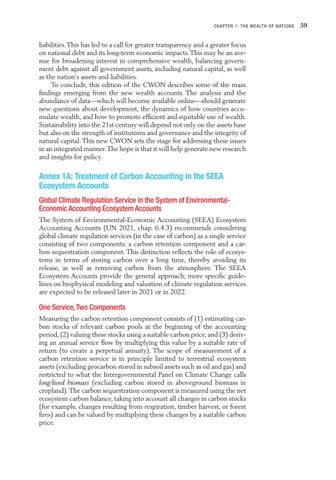C H AP TE R 1: T he Wea lth o f Nation s
liabilities. This has led to a call for greater transparency and a greater focus on national debt and its long-term economic impacts. This may be an avenue for broadening interest in comprehensive wealth, balancing government debt against all government assets, including natural capital, as well as the nation’s assets and liabilities. To conclude, this edition of the CWON describes some of the main findings emerging from the new wealth accounts. The analysis and the abundance of data—which will become available online—should generate new questions about development, the dynamics of how countries accumulate wealth, and how to promote efficient and equitable use of wealth. Sustainability into the 21st century will depend not only on the assets base but also on the strength of institutions and governance and the integrity of natural capital. This new CWON sets the stage for addressing these issues in an integrated manner. The hope is that it will help generate new research and insights for policy.
Annex 1A: Treatment of Carbon Accounting in the SEEA Ecosystem Accounts Global Climate Regulation Service in the System of EnvironmentalEconomic Accounting Ecosystem Accounts The System of Environmental-Economic Accounting (SEEA) Ecosystem Accounting Accounts (UN 2021, chap. 6.4.3) recommends considering global climate regulation services (in the case of carbon) as a single service consisting of two components: a carbon retention component and a carbon sequestration component. This distinction reflects the role of ecosystems in terms of storing carbon over a long time, thereby avoiding its release, as well as removing carbon from the atmosphere. The SEEA Ecosystem Accounts provide the general approach; more specific guidelines on biophysical modeling and valuation of climate regulation services are expected to be released later in 2021 or in 2022.
One Service, Two Components Measuring the carbon retention component consists of (1) estimating carbon stocks of relevant carbon pools at the beginning of the accounting period, (2) valuing these stocks using a suitable carbon price, and (3) deriving an annual service flow by multiplying this value by a suitable rate of return (to create a perpetual annuity). The scope of measurement of a carbon retention service is in principle limited to terrestrial ecosystem assets (excluding geocarbon stored in subsoil assets such as oil and gas) and restricted to what the Intergovernmental Panel on Climate Change calls long-lived biomass (excluding carbon stored in aboveground biomass in cropland). The carbon sequestration component is measured using the net ecosystem carbon balance, taking into account all changes in carbon stocks (for example, changes resulting from respiration, timber harvest, or forest fires) and can be valued by multiplying these changes by a suitable carbon price.
39


